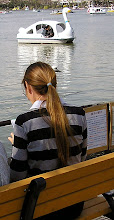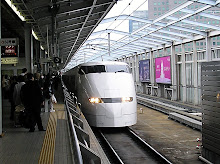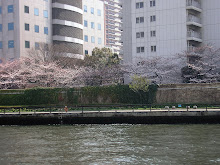Tsumago juku to Magome juku by Mr Julie - walked in October 2013
The 8km mountain-pass walk between Tsumago juku and Magome juku is the best preserved/restored section of the historical Edo period
NAKASENDO HIGHWAY walking route between Kyoto and the capital at the time, Edo (now the site of Tokyo). It is also part of an earlier Kiso Valley regional transport route.
The Edo period (1603-1867) was ruled by the dominant
Tokugawa shogunate who kept the rest of the shoguns (lesser ruling class) and
daimyo (regional warlords) in line partly by proclaiming 5 major transport
routes for the nation along which all major travel needed to be done. The
NAKASENDO (central main route) was the inland route between Kyoto and Edo.
The other major Kyoto-Edo route was the famous TOKAIDO (eastern sea route)
which was less favoured by many because of frequent wide river crossings. My Mount
Fuji page includes a section on a short walk along the TOKAIDO.
The walk (white route) parallels the more recent road and actually joins it for short sections. Signposting is good. The distance between the two towns is approximately 8km and can be walked in 2 to 3 hours. Most reports advise walking north to south (Tsumago to Magome) which we did. This is probably because the first 800m or so from the south thru the preserved/restored part of Magome-juku is seriously uphill and may not be the best way to start a long hike if you are not particularly fit. There is not too much difference in other gradients. The top of the Jukkyoku pass is considerably closer to Magome - about 5.5km into the 8km north-south walk.
I tilted this modified Google Earth image to try to give some idea of the landscape. It makes the top of the pass look about half way rather than much closer to Magome. There is seriously nice mountain scenery, streams and waterfalls along the route. Some cemeteries, old mills and historic bridges. Frequent bells on post with signs "RING LOUDLY TO FRIGHTEN BEARS" had this Aussie bushman who doesn't give a damn about snakes, wild dogs and spiders ringing like crazy. However late in the walk we passed a local guide with a couple of tourists - he completely ignored a nearby bell.
Access to our start from Tsumago juku (note miss-spelling in shot - too difficult to change) was by a 5 minute bus ride from Nagiso railway station which is part of the main Chuo line between Matsumoto and Nagoya. The trip from Matsumoto is lovely with outstanding valley and mountain views. Only local trains stop at Nagiso. At the end of our walk we exited Magome juku (again miss-spelled!) by bus to Nakatsugawa railway station (15 minutes). Express trains stop here. Note you can't do Matsumoto to Nakatsugawa or Nagiso on an Eastern JR Rail pass - don't ask how I know this. A general JR Rail Pass will work from both Matumoto to the north and Nagoya to the south.
We started with a 15 minutes stroll thru the restored part of Tsumago juku. This section was the 42nd of 69 post towns (places where travellers stopped overnight) between Edo and Kyoto. As such most of these buildings which date from the mid-1700s used to be inns, restaurants, stables, temples or shops.
Current use of the restored buildings is largely for touristy activities like restaurants, souvenirs, and craft shops like these traditional wood carvers, although some are dwellings. There is a tourist information office about midway through the old town with good maps etc. The whole trek is very foreign-tourist friendly with abundant signs and information in English. Most of the tourists we saw were domestic. There is also tourist accommodation - these places will send luggage on to the other end to meet you at the conclusion of your walk.
Some seriously nice countryside is passed through. The track goes over probably a dozen creeks along the way. Short side tracks lead to waterfalls and viewpoints.
The road roughly parallels the path, but because cars were not very powerful when it was put in the road often takes a longer, easier route. Reasonably frequent buses run between the two towns which allows people to walk one way and ride back. Unfit people who don't like uphill walking could catch the bus up to the top of the pass, walk downhill to the next town, catch the bus uphill to the top of the pass again and walk down to their original starting point.
The ruling Tokugawa clan further made it difficult for
plotters and other enemies with a decree that wheeled transport was forbidden
on the routes. Shoguns could ride horses, lesser big-wheezes travelled in palanquins (kago/norimono) and the hoi-polloi walked (although they were allowed to hire a ride on black
cattle over steep sections). Post towns provided porters, fresh horses for the top dudes etc.
The narrowness of the path must have made it interesting when two groups passed. I'm told flunkies travelled ahead of big wheezes announcing their imminent arrival and groups lower in status had to clear the way. As a matter of fact if they didn't scrape and bow they risked losing their heads. It must have been interesting when groups of equal status met. Any imagined slight or loss of face was a major thing with these dudes and they would rather have a fight than a feed.
This is one of the steeper sections. However fit people will find this a doddle. People of average fitness may need a stop or two, seriously unfit people will not be impressed. They could use the uphill bus/downhill walk system suggested above. If they only have time to do the bus/walk in one direction I'd suggest going south-north from Magome juku to Tsumago juku. Although the walk is longer it has the most authentic restored section of the path and is virtually all downhill. Going the other way sees quite a lot of main or secondary roadway and more uphill sections on the walk.
Please excuse the lack of clarity in the above pic - I shot it on the move and the dim conditions meant a longer shutter opening which the image stabiliser on my elcheapo pocket Olympus couldn't correct.
Another shaky shot, this time because my non-working flash meant an even longer shutter opening. But this is the only pic I took of a rather nice rest stop about half way along the track in a traditional wayside building. Free green tea and information were available. The outside toilets were spotless. There is no shortage of wcs along the path. No shortage of distance or direction signs either.
The constant rain saw us scuttle through the walk, reluctant to take any of the side paths. So I have had to pinch this great pic of the "male" waterfall off Google Earth's embedded shots - taken by Rod Williams (Panoramio) - looks like Rod passed by in winter. Apparently there is a "female" waterfall nearby.
Similarly the mist and low cloud made viewpoint shots impossible - this nice shot comes from Panoramio's imakuman
The constant rain saw us scuttle through the walk, reluctant to take any of the side paths. So I have had to pinch this great pic of the "male" waterfall off Google Earth's embedded shots - taken by Rod Williams (Panoramio) - looks like Rod passed by in winter. Apparently there is a "female" waterfall nearby.
Similarly the mist and low cloud made viewpoint shots impossible - this nice shot comes from Panoramio's imakuman
End of the walk for us - Magome juku. The restored section along the original path once again has mainly buildings from the mid 1700s and similar activities to Tsumago juku. The gradient is steeper than it appears in this shot. Regular buses leave for Nakatsugawa railway station 50m to the right from the bottom of this section.
Nice colour and sweet building restoration. I'm no expert in Japanese architecture but this one looks a bit more recent than mid-1700s. Still, not hard on the eye.
Please note that comments are welcome, but we do not check the blog regularly enough to answer questions. Please post your questions on Lonely Planet Thorntree, where you will get the benefit of other posters' wisdom. Alternatively you could post your question on my island and beaches blog forum which gets looked at most days.

















1 comment:
You are helping others to grow their knowledge by sharing such a valuable information very helpful
Thanks Again
japan Hokkaido tour
Post a Comment